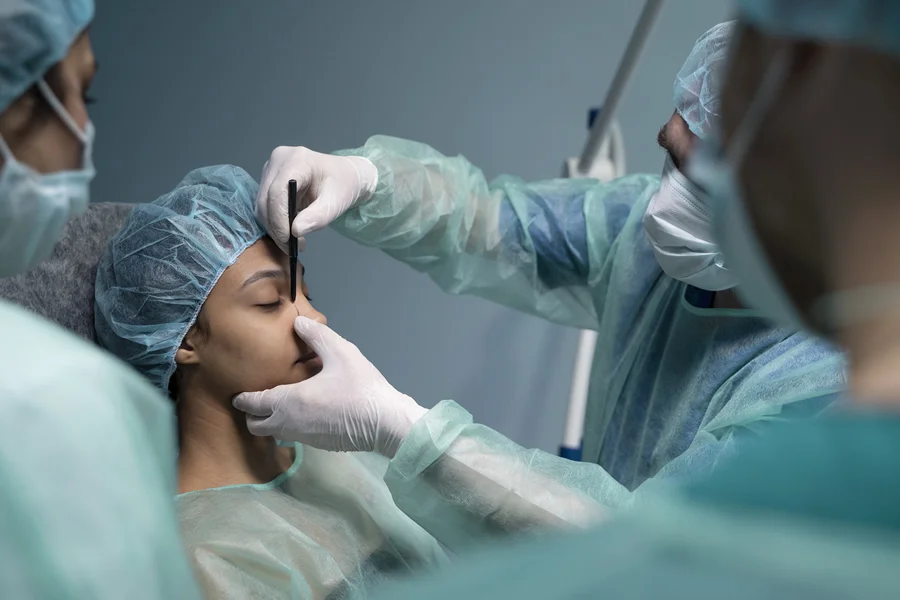Op. Dr. Burkay Akduman
Rhinoplasty in Turkey
Rhinoplasty, commonly known as a nose job, is one of the most popular cosmetic procedures worldwide. Whether for cosmetic reasons, medical needs, or both, rhinoplasty can enhance the appearance and function of the nose. In this blog, we’ll explore everything you need to know about rhinoplasty—what it involves, who should consider it, and the benefits …
Rhinoplasty, commonly known as a nose job, is one of the most popular cosmetic procedures worldwide. Whether for cosmetic reasons, medical needs, or both, rhinoplasty can enhance the appearance and function of the nose. In this blog, we’ll explore everything you need to know about rhinoplasty—what it involves, who should consider it, and the benefits it offers.
What is Rhinoplasty?
Rhinoplasty is a surgical procedure aimed at changing the shape, size, or function of the nose. It can be performed for aesthetic reasons (to improve the appearance of the nose) or for medical reasons (such as correcting breathing problems or repairing a broken nose). The surgery involves modifying the bone, cartilage, or skin to reshape the nose, and it can also correct structural issues like a deviated septum.
Why Do People Choose Rhinoplasty?
- Aesthetic Reasons
Rhinoplasty can significantly enhance facial symmetry and balance. Some people feel that their nose is too large, small, crooked, or disproportionate to the rest of their face. By reshaping the nose, rhinoplasty can help create a more harmonious and attractive facial appearance.
- Medical Reasons
In addition to cosmetic improvements, rhinoplasty is often used to treat medical conditions. A deviated septum, for instance, can obstruct airflow and cause difficulty breathing. Rhinoplasty can help correct these issues, improving both function and appearance.
- Correcting Injuries
Accidents or injuries to the nose can lead to deformities or functional problems. Rhinoplasty can restore the nose’s appearance and improve its function, especially after trauma or injury.
The Rhinoplasty Procedure
The rhinoplasty procedure typically lasts between one to three hours, depending on the complexity of the surgery. It is usually performed under general anesthesia, although in some cases, local anesthesia may be used with sedation. There are two primary techniques used in rhinoplasty:
1. Closed Rhinoplasty
This method involves making incisions inside the nostrils, which means there are no visible scars. It’s typically used for less complex reshaping.
2. Open Rhinoplasty
For more complex cases, an incision is made across the columella (the strip of tissue between the nostrils), allowing the surgeon to lift the skin and access the underlying structure of the nose. This approach provides greater visibility and precision for intricate adjustments.
What to Expect After Surgery?
After rhinoplasty, patients can expect some swelling, bruising, and discomfort, especially around the nose and eyes. These side effects usually subside after a few days to weeks. Most people can return to work or school within 7–10 days, though strenuous activities and exercise should be avoided for several weeks.
You’ll need to follow post-operative instructions carefully, including wearing a nasal splint or bandage and taking prescribed medications for pain management and infection prevention.
Results and Recovery
The final results of rhinoplasty take time to fully appear. Swelling will gradually subside, and the nose will settle into its new shape over several months. While some initial changes can be seen within a few weeks, the complete outcome may take up to a year to become fully visible.
It’s essential to have realistic expectations and understand that rhinoplasty is an art form as much as it is a science. Each nose is unique, and the goal of the surgery is to enhance your facial features in a balanced and natural way.
Who is an Ideal Candidate for Rhinoplasty?
The ideal candidate for rhinoplasty is someone who is in good overall health, has realistic expectations, and is looking to improve either the aesthetic or functional aspects of their nose. It’s essential for candidates to be fully mature and have a stable psychological state to handle the changes that rhinoplasty brings.
If you’re considering rhinoplasty, it’s crucial to consult with an experienced and board-certified plastic surgeon. They will evaluate your nose, discuss your goals, and help determine the most suitable approach for your needs.
Rhinoplasty offers a transformative opportunity for those looking to improve the appearance and functionality of their nose. Whether you’re seeking cosmetic enhancement or relief from breathing issues, rhinoplasty can bring significant benefits to your facial harmony and quality of life. With the right surgeon and realistic expectations, rhinoplasty can help you achieve the results you desire, giving you a nose that complements your face and boosts your confidence.
